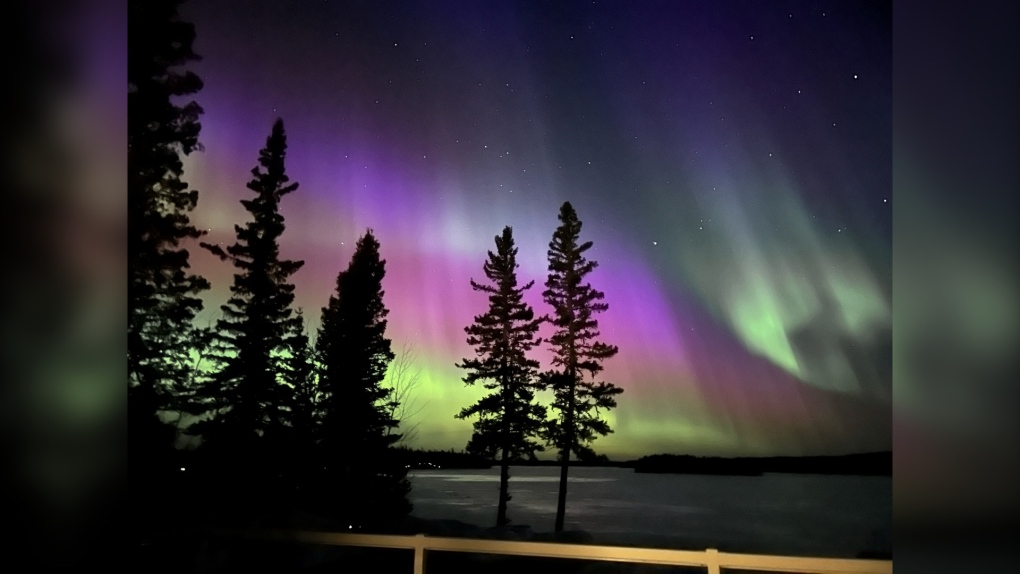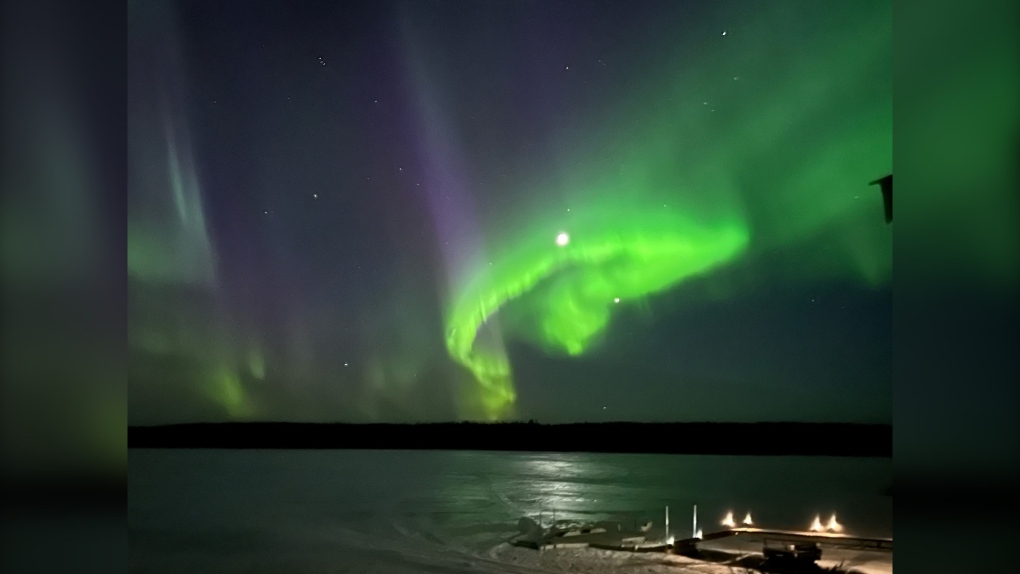'Burst' of northern lights activity creates eye-catching celestial show in Manitoba skies
The northern lights illuminated skies throughout Manitoba Sunday night, creating a dazzling show for sky gazers across the province.
Manitoba Museum planetarium astronomer Scott Young told CTV News Winnipeg the northern lights were vivid through many parts of Manitoba, even stretching into central and southern portions of the United States on Sunday night.
Photos from CTV viewers flooded our inbox showing an array of aurora from Flin Flon to Cross Lake to Russell, Man.
“There were a lot of great spots across the province that had these beautiful shows, and it's all because of what's going on on the sun,” Young said.
According to the astronomer, when there's a burst of activity on the sun, that energy eventually arrives on earth and interacts with its atmosphere, causing the northern lights.
 The northern lights are shown over Setting Lake, Man. on April 23, 2023. (Source: Shirley Sim)
The northern lights are shown over Setting Lake, Man. on April 23, 2023. (Source: Shirley Sim)
Young said it’s hard to predict when northern lights will be most visible, and generally arrive in bursts for a few hours at a time before returning to their lower level.
“We had about an hour's warning for last night's show pretty much that it was actually going to happen,” he recalled.
“So the best way to see northern lights is to spend a lot of time out looking at the sky, and eventually you will see them.”
Young added they are best viewed away from city lights on clear nights. He also noted the Facebook group Manitoba Aurora and Astronomy gives frequent updates on northern lights activity and sightings.
 The northern lights are shown over Setting Lake, Man. on April 23, 2023. (Source: Shirley Sim)
The northern lights are shown over Setting Lake, Man. on April 23, 2023. (Source: Shirley Sim)
FULL MOONS TO WATCH FOR IN 2023
There are more celestial sights forecasted for Manitoba skies in the next few months.
The Farmers’ Almanac released a complete list of full moons remaining in 2023, including a flower moon predicted for May 5 and a strawberry moon coming around June 3.
Young said these moons were named as part of the earliest human calendar, when people would keep track of the passage of time based on the moon’s position.
“(They) gave it a name or they related it to what's going on in the seasons. So many cultures have come up with names - the flower moon, the strawberry moon, many of the First Nations people here in Canada have their own names that would basically relate to the area that they were living in,” he explained.
Young notes moons can be beautiful to look at any stage, and a household pair of binoculars are the perfect aid to help view the natural satellite.
“You'll be able to see the craters and the mountains. It's almost like being there.”
CTVNews.ca Top Stories

Donald Trump says he urged Wayne Gretzky to run for prime minister in Christmas visit
U.S. president-elect Donald Trump says he told Canadian hockey legend Wayne Gretzky he should run for prime minister during a Christmas visit but adds that the athlete declined interest in politics.
Historical mysteries solved by science in 2024
This year, scientists were able to pull back the curtain on mysteries surrounding figures across history, both known and unknown, to reveal more about their unique stories.
King Charles III focuses Christmas message on healthcare workers in year marked by royal illnesses
King Charles III used his annual Christmas message Wednesday to hail the selflessness of those who have cared for him and the Princess of Wales this year, after both were diagnosed with cancer.
Mother-daughter duo pursuing university dreams at the same time
For one University of Windsor student, what is typically a chance to gain independence from her parents has become a chance to spend more time with her biggest cheerleader — her mom.
Thousands without power on Christmas as winds, rain continue in B.C. coastal areas
Thousands of people in British Columbia are without power on Christmas Day as ongoing rainfall and strong winds collapse power lines, disrupt travel and toss around holiday decorations.
Ho! Ho! HOLY that's cold! Montreal boogie boarder in Santa suit hits St. Lawrence waters
Montreal body surfer Carlos Hebert-Plante boogie boards all year round, and donned a Santa Claus suit to hit the water on Christmas Day in -14 degree Celsius weather.
Canadian activist accuses Hong Kong of meddling, but is proud of reward for arrest
A Vancouver-based activist is accusing Hong Kong authorities of meddling in Canada’s internal affairs after police in the Chinese territory issued a warrant for his arrest.
New York taxi driver hits 6 pedestrians, 3 taken to hospital, police say
A taxicab hit six pedestrians in midtown Manhattan on Wednesday, police said, with three people — including a 9-year-old boy — transported to hospitals for their injuries.
Azerbaijani airliner crashes in Kazakhstan, killing 38 with 29 survivors, officials say
An Azerbaijani airliner with 67 people onboard crashed Wednesday near the Kazakhstani city of Aktau, killing 38 people and leaving 29 survivors, a Kazakh official said.

































